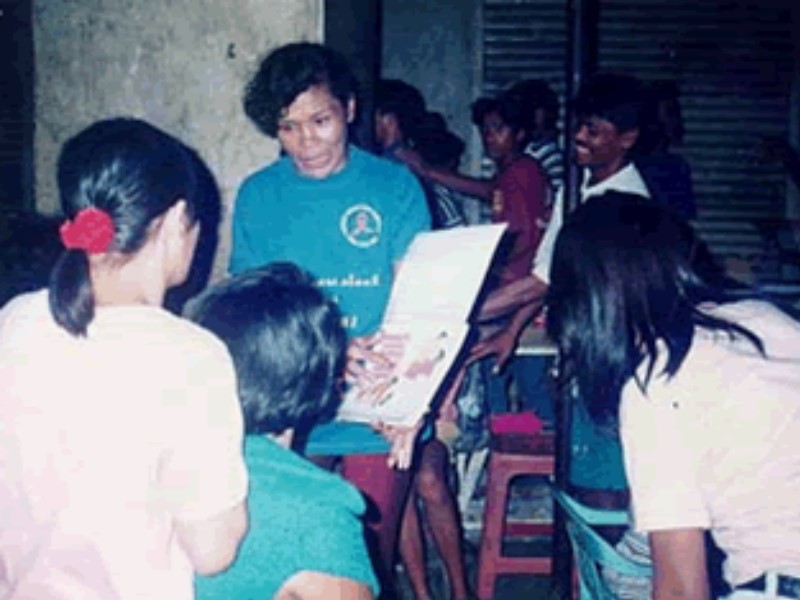The education component of the AIDS Surveillance and Education Project (ASEP) is being implemented by PATH and selected private sector partners working in collaboration with the Philippine Department of Health (DOH), the U.S. Agency for International Development (USAID), and the World Health Organization (WHO).
Inputs and Intervention Strategies
At the interpersonal level, PATH and its non-government organization (NGO) partners assist vulnerable individuals to recognize and modify their HIV risk-taking behaviors. Education interventions are based on theories of social learning and communal and peer support for incremental risk reduction, based on the recognition that behavior change occurs slowly and in stages.
One-on-one education is combined with guided group interactions that foster solidarity and skills building for condom use, safer sex negotiation, and appropriate STD treatment-seeking. Interpersonal communication is reinforced by mass media messages designed to increase public awareness of STD symptoms and referral mechanisms, desensitize condom use, and encourage consistent use of condom among individuals who have multiple sex partners.
At the local level, the program facilitates institutional capacity building by organizing and supporting multisectoral committees to develop and coordinate city plans of action for STD/HIV/AIDS prevention targeted at the “hospitality” industry and the informal sex sector. Among others, these plans promote solidarity for 100% condom use in licensed establishments based on the premise that “What’s good for entertainers is good for customers is good for business.” Sex establishment owners are also encouraged to comply with provisions of the labor code prohibiting employment of minors and the Sanitation Code, which mandates regular STD check-ups for “hospitality” workers. Community organizing efforts among freelance sex workers serve a similar purpose of building solidarity and skills for condom use and refusal of unprotected sex.
At the national level, PATH coordinates closely with DOH’s Field Epidemiology Training Program (FETP), which is managing the surveillance systems that monitor prevalence of HIV and high risk behaviors in ASEP sites. NGO collaborators contribute to surveillance objectives by facilitating access to vulnerable groups for HIV testing and behavioral surveys, and by providing post-HIV test counseling after surveillance rounds.
PATH and collaborators also work closely with the DOH’s National AIDS/STD Prevention and Control Program (NASPCP) and the devolved health services to transfer know-how in STD syndromic case management to public and private service providers. Training inputs are followed-up with continuing STD case management practice. Once capacity for improved STD management has been strengthened, the program leverages resources from media concerns to disseminate public service announcements (PSA) designed to mobilize and refer symptomatic individuals to government and NGO service points for STD testing and treatment. Once capacity for improved STD management has been strengthened, the program leverages resources from media concerns to disseminate public service announcements (PSA) designed to mobilize and refer symptomatic individuals to government and NGO service points for STD testing and treatment (scroll down the page to access links to PSAs on YouTube).
Prevention Effectiveness
Four independent reviews of the program have documented evidence to support the conclusion that ASEP is helping to moderate the spread of HIV in the Philippines . A mid-term program review in 1995 confirmed the efficiency of ASEP’s targeted information, education and communication (IEC) intervention strategy and applauded the innovative public-private sector partnerships that the education component has fostered at local levels. Recognizing its potential as a “model for low HIV prevalence countries,” the review team offered suggestions for fine-tuning ASEP’s monitoring systems and education interventions, which have since been adopted and implemented by the DOH, PATH, and NGO partners
Too Many Mouths to Feed
“It is an indication of the severity of the fish production problems worldwide that, for the first time, UNICEF has measured in its global report protein-calorie deficiency in fishing communities. According to projections of the per capita food fish supply based on trends in fish production decline and population increase, if no action is taken in the Philippines, the annual portion of fish that could be available to each person would decline to about 10 kilograms by 2010, down from current estimates of 24 kilograms (Bernascek 1994). This picture is bleak especially for a country like the Philippines where as much as 80% of the dietary protein requirements in rural areas come from fish.”


